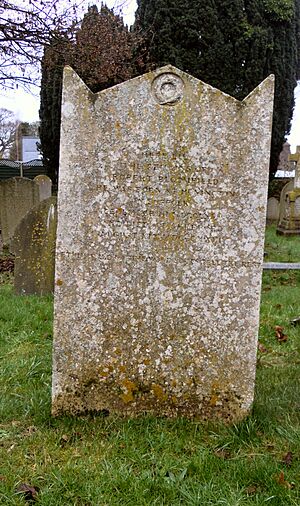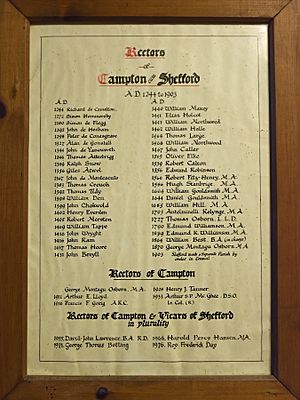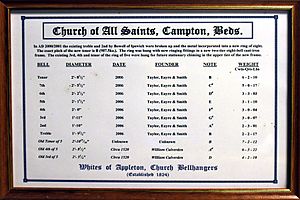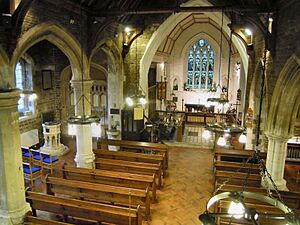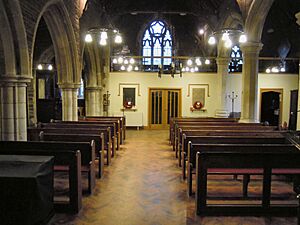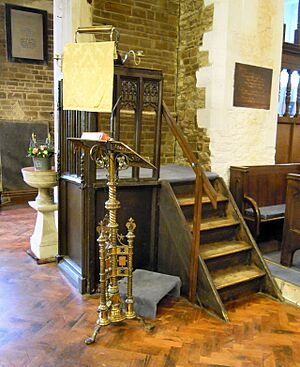Church of All Saints, Campton facts for kids
Quick facts for kids Church of All Saints, Campton |
|
|---|---|

Campton All Saints Church
|
|
| Country | England |
| Denomination | Church of England |
| History | |
| Status | Parish church |
| Architecture | |
| Functional status | Active |
| Administration | |
| Parish | Campton |
| Deanery | Ampthill & Shefford |
| Archdeaconry | Bedford |
| Diocese | St Albans |
The Church of All Saints is an Anglican parish church located in the village of Campton, near Shefford, in Bedfordshire, England. It serves the villages of Campton and Chicksands. Even though a nearby military base has its own church, the Church of All Saints is the main Anglican parish church for the area.
This historic building has been recognized as a Grade II* listed building since 1966. This means it is a very important building with special historical or architectural interest.
Contents
History of the Church
The Church of All Saints was first built in the 1200s. It was made from red sandstone blocks. Over the past 800 years, parts of the church have been added to and rebuilt many times. For example, the Osborn Mausoleum and Osborn Chapel were added in 1649. These parts form the northern side of the church. You can see the Osborn family's symbols and mottoes inside. Their Latin motto, 'Quantum in Rebus Inane,' means 'What vanity in human affairs.'
The church tower is about 43 feet (13 meters) tall and 10 feet (3 meters) wide. It was added in the 1400s. The church was updated in the late 1800s. During this time, the tower was rebuilt with well-cut sandstone. An organ was also installed, which is thought to have come from Chicksands Priory.
The famous poet Robert Bloomfield (1766-1823) is buried in the churchyard. He was known for his poems about country life. Although he lived and died in Shefford, he was buried in Campton. This is because the church in Shefford was a "Chapel of Ease." This meant it was a smaller church connected to All Saints and did not have its own burial ground. Shefford's church became its own separate parish in 1903. The first church records for Campton, which included Shefford, started in 1568.
The churchyard also has one Commonwealth War Grave from the First World War. This marks the burial place of a soldier who died in that war.
Church Leaders: Rectors and Vicars
Church records show that a rector has been leading services at the church since at least 1215. The church's history also involves changes to its parish boundaries over time. Sometimes, a rector would lead two parishes at once. This is called being held in "plurality." This happened twice for All Saints. From 1955 to 1976, it was linked with Shefford. Then, from 1976 to 1982, it was linked with Meppershall and Stondon.
The names of the rectors listed below come from records kept by Central Bedfordshire Council. There is also a list of rectors displayed inside the church. The current leader is the Reverend Dean Henley, who started in 2006.
| Year | Name | Year | Name | Year | Name | Year | Name | |||
|---|---|---|---|---|---|---|---|---|---|---|
| 1215 | William | 1402 | Henry Everedon | 1552 | Edward Robinson | 1911 | Arthur E Lloyd | |||
| 1244 | Richard de Camelton | 1405 | Robert Merston | 1566 | Robert Fitzhenry | 1916 | Francis Fairchild Greig | |||
| 1273 | Simon de Hemmesby | 1409 | William Tappe | 1586 | Hugh Stanbridge | 1928 | Henry James Tanner | |||
| 1280 | Simon de Fegg | 1416 | John Wryght | 1604 | William Gouldsmith | 1933 | Arthur Sydney P McGhee | |||
| 1292 | John de Hecham | 1416 | John Ram | 1644 | Daniel Gouldsmith | 1955 | David John Lawrence | |||
| 1298 | Peter de Conesgrave | 1417 | Thomas Thorne | 1686 | William Hill | 1966 | Harold Percy Hansen | |||
| 1327 | Alan de Gonshill | 1431 | John Bevyll | 1703 | Antelminelli Kelynge | 1971 | George Thomas Botting | |||
| 1344 | John De Ganeworth | 1440 | William Maxey | 1709 | Richard Finch | 1976 | Roy Frederick Day | |||
| 1346 | Thomas Atterbrigg | 1441 | Elias Holcott | 1711 | John Keye | 1982 | Gordon Hamilton Waller | |||
| 1349 | Ralph Snow | 1441 | William Northwold | 1716 | Matthew Hanscombe | 1987 | William David B Williams | |||
| 1350 | Giles atte Well | 1462 | William Halle | 1727 | Thomas Osborn | 1991 | John Henry Barrall | |||
| 1367 | John De Monte Acuto | 1464 | Thomas Large | 1748 | Jacob Janeway | 1999 | David W Renshaw | |||
| 1383 | Thomas Crouch | 1466 | William Northwold | 1790 | Edmond Williamson | 2002 | Margaret Joy Venables | |||
| 1392 | Thomas Tydy | 1467 | John Caller | 1839 | Edmond Riland Williamson | 2006 | Dean Henley | |||
| 1398 | William Den | 1505 | Oliver Elke | 1864 | William Best | |||||
| 1400 | John Chokwold | 1539 | Robert Catton | 1870 | George Montague Osborn |
The Church Bells
The church tower has 11 bells. Two of these bells were made in 1520 by William Culverden. Eight new bells were made for the tower in 2006 by John Taylor & Co in Loughborough. These new bells were hung next to the three older ones. They were officially dedicated on July 1, 2007, in a special ceremony led by the Bishop of Bedford.
The Campton Bell-Ringers ring the bells for Sunday morning services. The bells are also used in bell ringing competitions.
Inside the Church
The church has many interesting features. You can see two piscinas, which are stone basins used for washing sacred vessels. One is near the altar, and another is in the south chapel. There are also special spaces for statues and plaques that remember people who have passed away. Seven plaques and windows are dedicated to members of the Osborn family from Chicksands Priory. The oldest plaque dates back to 1489. It remembers Richard Carlyll and his wife Joan, who both died on the same day.
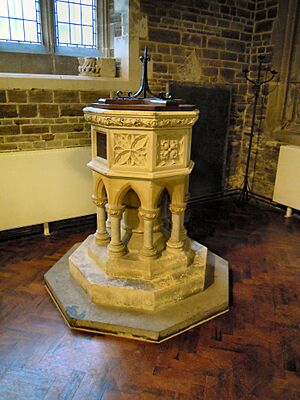
Some of the beautiful stained glass windows remember people. The large east window shows 16 saints and the Lamb of God. A window on the south wall of the chancel (the area around the altar) shows the Christian virtues of Faith, Hope, and Charity. These windows were designed by Heaton, Butler and Bayne and made by Chance Brothers. They were dedicated in 1912.
The west end of the church has a large gallery, which was built in 2002 by Peter Farmer. Below the gallery is the Fred Oakley Room. This room is named after Fred Oakley, a Campton resident who helped the church a lot before he passed away in 2000. On either side of the entrance to this room are two war memorials. They remember the men from Campton who died in World War I and World War II. The oak screens that form parts of the ringing chamber are from the 1400s. They used to be part of the chancel screen.
The north wall of the church was built in 1649. It includes pieces of stone that are believed to have come from Chicksands Priory. Monuments on this wall remember Sir Danvers Osborn and Reverend Arthur McGee. The fancy baptismal font was installed around 1893. It remembers the Hon. Charlotte Osborn. The Gothic-style lectern (a stand for reading) is from the late 1800s. The pulpit (where sermons are given) is made from parts of a screen from the 1300s.
A two-tiered glass screen from 1649 separates the chancel from the Osborn Chapel. The communion rail is from the 1700s. The church once had a wooden screen from 1670, but it was destroyed in a fire in 1960. The altar is framed by an arch with carved heads. The organ, possibly from Chicksands Priory, was installed in its special room in 1894.
The Osborn Chapel has monuments to members of the Osborn Family. These include two large white marble altars with carved family symbols. These memorials are great examples of 17th-century church sculptures. They remember people like Sir Peter Osborn, who was a governor during a siege, and John Osborn, a diplomat who was held captive by Napoleon Bonaparte.
The church also has many examples of old graffiti carved into the stone. When the church was restored in 1895, workers tried to use as much of the original stone as possible. Because of this, some graffiti can be found in unexpected places, like the ringing chamber, the Oakley Room, and the gallery.
A memorial made of Welsh stone was installed in 2003 to honor the poet Robert Bloomfield, who is buried in the churchyard.
Images for kids


